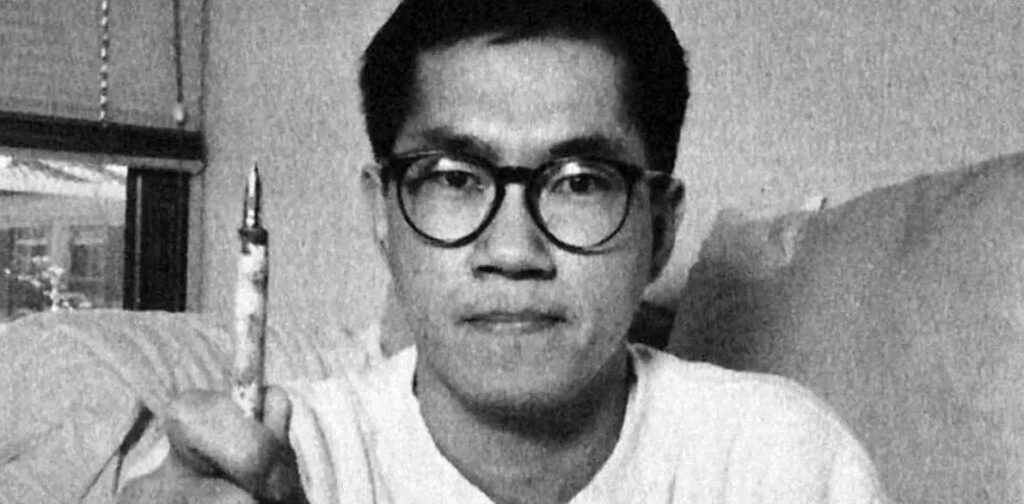Akira Toriyama (1955-2024)
March 8, 2024 · 0 comments

The manga creator Akira Toriyama, who died on 1st March, was cited by the editor-in-chief of Weekly Shonen Jump as being the prime catalyst in driving the magazine to its six-million circulation in the 1980s. The antic humour of his Doctor Slump (1980-84) and the sprawling, brawling sci-fi saga Dragon Ball (original series 1984-95) made them definitive works in Bubble-era boys’ manga, propelling them through their anime incarnations into worldwide success, particularly in Europe and South America. Dragon Ball, in particular, would become a much-referenced trope in international popular culture, in everything from the French rappers Saïan Supa Crew to the Hungarian rock band AWS, who launched into a Dragon Ball “ginyu force pose” upon arriving onstage at the 2018 Eurovision Song Contest.
A shy and reclusive figure, Toriyama sometimes admitted that his unease during interviews led him to be more jokey and dismissive about his work than he really should have been. A heavy smoker, he once claimed that he only entered a manga competition to win more money for cigarettes. After a brief stint making posters at a design company, he claimed to have drifted into manga creation as a better fit for his habits of dressing down and sleeping in. Such a claim rather ignored his fiercely productive output in a high-pressure environment, for which he had to crank out weekly chapters, without fail, for fifteen solid years.

As a youth, the animal-loving Toriyama was taken with Osamu Tezuka’s Astro Boy and Disney’s 101 Dalmatians, but his true love was Bruce Lee in Enter the Dragon – released when Toriyama was in his late teens, the kung fu classic lured him back to the cinema three times a day for nearly a fortnight. After he married the manga artist Nachi Mikami in 1982, his wife introduced him to the works of Jackie Chan. A particular fan of the Drunken Fist movies, Toriyama could reportedly be found working on his manga with the films playing in the background, not watching them, but fired up by the “Hyaaaghs!” and “Aiiees!” on the soundtrack.
Often making the story up as he went along, Toriyama conceived of a “Dragon” title from Enter the Dragon and its imitators, and a quest-based, collecting narrative inspired by the eight magical stones of the samurai-era classic The Hakkenden. He named his hero Son Goku, the Japanese pronunciation of Sun Wukong, the name of the Monkey King in the Chinese novel Journey to the West, and expected that the journey to collect the magical, wish-granting “dragon balls” would only take a year to wrap up. Instead, it occupied him for over a decade, leaping partway to an animated adaptation, itself generating several spin-offs.

Along the way, Toriyama also enjoyed a parallel career as the character designer for the Dragon Quest series of computer games, as well as Chrono Trigger and Blue Dragon. But it was Dragon Ball that truly made his name, with the manga often sneaking into foreign markets behind the anime, which would eventually go on-air in eighty countries. It was, in fact, supposedly Toriyama’s influence as a manga creator that pushed the overseas manga world into right-to-left printing. It had formerly been standard practice for foreign manga publishers to flip their pagination so it read left-to-right. When Dragon Ball came out in Spain, Toriyama was said to have insisted that his work be printed in its original format, opening the floodgates for the unflipped norm in the manga world today. Dragon Ball was not the first manga to appear unflipped, but the first to do so as a result of its creator’s preference – so, at least, the manga publishers of the world were led to believe.

Toriyama’s breakneck schedule and relatively small number of assistants led him to find a number of corner-cutting measures to streamline the manga production process. He liked to zoom in on characters whenever possible in order to reduce the necessary backgrounds, and if long-shots were required, he got his combatants out into the wilderness as quickly as possible, where there were fewer trees and buildings to worry about. After his assistant, Takashi Matsuyama, complained that he spent an unreasonable amount of time inking Son Goku’s spiky hair, Toriyama hit on the idea of a “Super Saiyan” transformation that turned the hero blond.
Similar behind-the-scenes hacks helped contribute to his idiosyncratic style. The son of an auto mechanic, he preferred to concentrate on weird and wonderful contraptions, while his wish to differentiate between faces and expressions inspired him to create multiple anthropomorphic animal characters, simply to add variation.
He received his first Macintosh computer from the animation company Bandai, and swiftly embraced the potential of digital media. “People often say that drawing on a computer is tasteless,” he once quipped, “but it’s not like I’m creating a work of art!” In his early days of analogue artwork, he avoided using screen tones because they were troublesome to apply; as a digital artist, he embraced them with alacrity.

The Dragon Ball series and its numerous spin-offs not only made Toriyama a fortune, but also established firm metrics for success in the world of boys’ manga. There are shadows of it to be glimpsed in all today’s modern successes, including Naruto, One Piece, Bleach and Fairy Tail. It can be seen all over popular culture, in the goal celebrations of sporting stars, in-ring wrestlers’ performances, in martial arts moves and hip-hop dances, gifs and memes… and, of course, the Hungarian 2018 Eurovision entry.
Leave a Reply